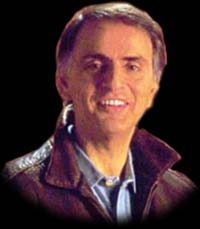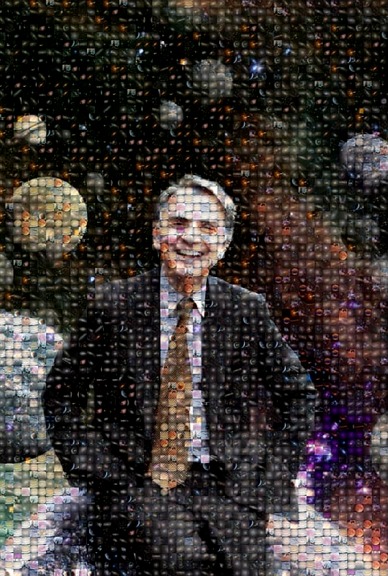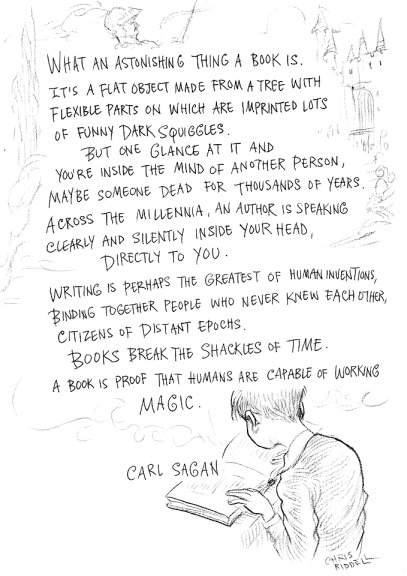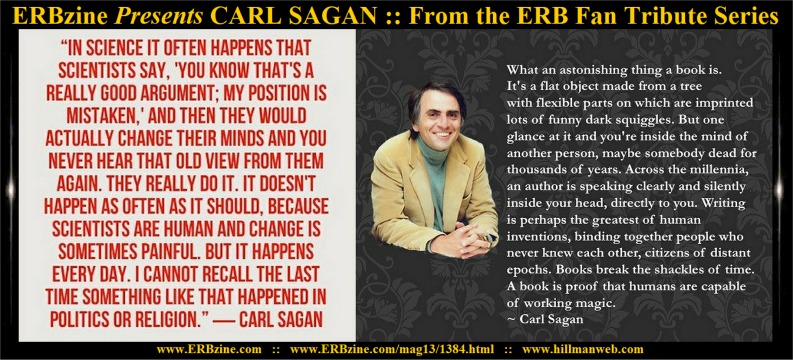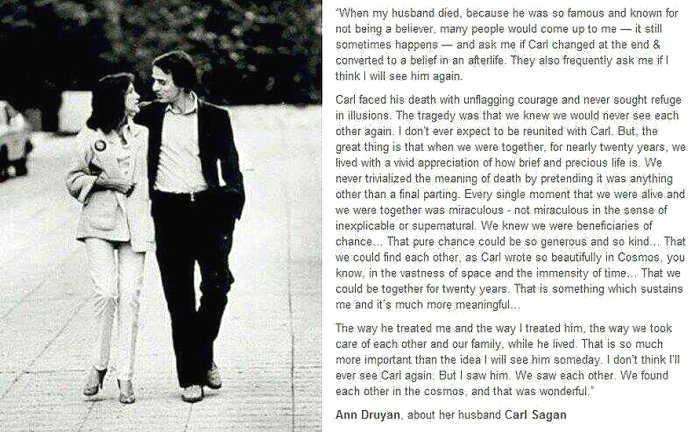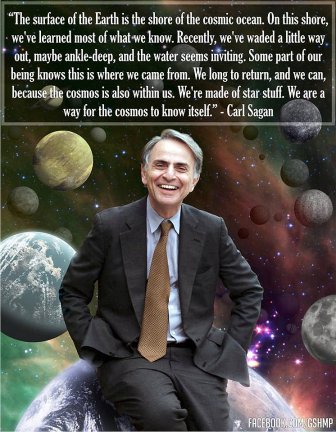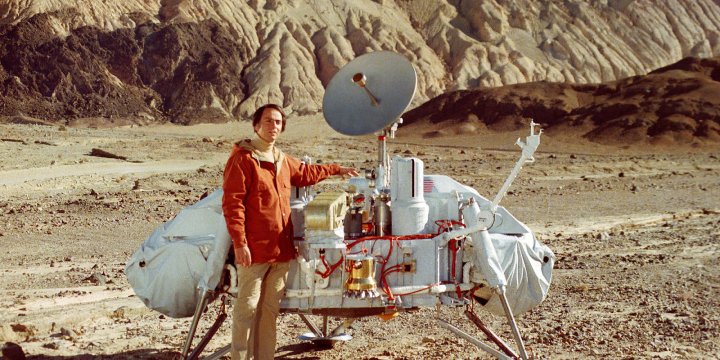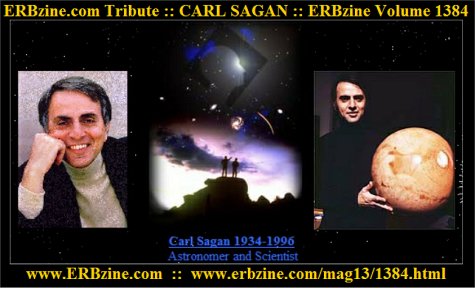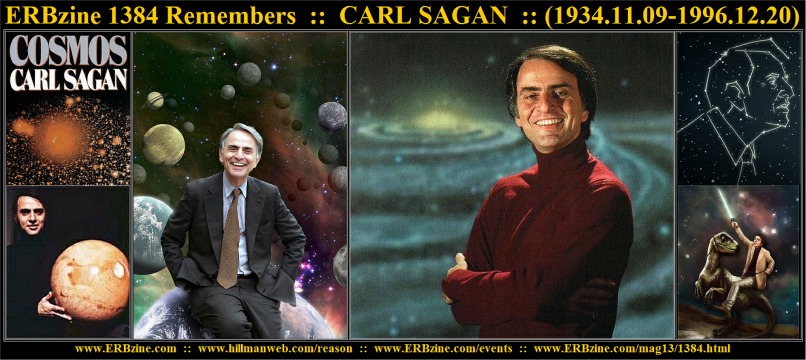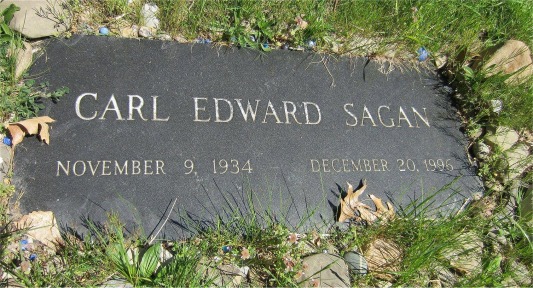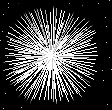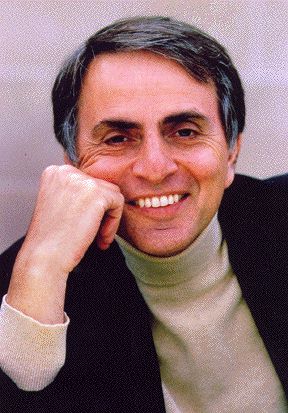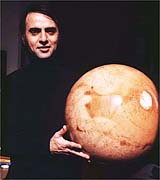Carl Sagan died Friday, December
20, 1996 in Seattle at the age of 62, of complications arising from bone
marrow cancer.
Sagan was the world's best known
astronomer as a result of hosting "Cosmos" a 1980 series on public television
which had an estimated audience of 400 million people. He was a prolific
writer with 600+ papers and articles and a distinguished scientist. Research
interests included the origins of life, nuclear winter, the possibility
of life in other locations in the universe.
His books included:
-
Broca's Brain: Reflections on the
Romance of Science
-
The Cold and the Dark: The World
After Nuclear War (co-author)
-
Comet (with Ann Druyan)
-
Contact (fiction)
-
The Cosmic Connection: An Extraterrestrial
Prospective
-
The Demon-Haunted world: Science
as a Candle in the Dark
-
The Dragons of Eden: Speculations
on the Evolution of Human Intelligence
-
Other Worlds
-
Pale Blue Dot
Shadows of Forgotten Ancestors:
A Search for Who We Are (with Ann Druyan)
Born: November 9, 1934,
Bensonhurst, Brooklyn, NY
Died: Friday, December
20, 1996, 62 years.
Education: University Chicago,
Ph.D. Astronomy and astrophysics.
Career: Fellowship, University
of California at Berkeley; Assistant Professor of Astronomy at Harvard
University; Professor Cornell. Consultant to NASA, Mariner, Viking and
Pioneer missions.
Positions: David Duncan
Professor of Astronomy and Space Sciences; Director of the Laboratory for
Planetary Studies at Cornell University; Chairman, Division for Planetary
Sciences, American Astronomical Society; President, Planetary Society;
Editor in Chief, Icarus.
Honors: Pulitzer Prize,
1978 "The Dragons of Eden: Speculations on the Evolution of Human Intelligence;"
Public Welfare Medal, the National Academy of Science; Medal for Distinguished
Public Service, NASA;
Family: Wives: Lynn Margulis
(divorced); Linda Salzman (divorced); Ann Druyan;
Sons: Dorion, Jeremy,
Nicholas, Sam; Daughter: Alexandra. One grandchild. Sister: Cari Sagan
Greene.
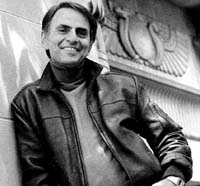
IN
HIS OWN WORDS...
"The Cosmos is all that is or ever
was or ever will be. Our feeblest contemplations of the Cosmos stir us
- there is a tingling in the spine, a catch in the voice, a faint sensation,
as if a distant memory, of falling from a height. We know we are approaching
the greatest of mysteries."
-"The Shores of the Cosmic Ocean," Cosmos, p. 4.
ON
EDGAR RICE BURROUGHS:
"I can remember as a child reading
with breathless fascination the Mars novels of Edgar Rice Burroughs. I
journeyed with John Carter, gentleman adventurer from Virginia, to "Barsoom,"
as Mars was known to its inhabitants. I followed herds of eight legged
beasts of burden, the thoats. I won the hand of the lovely Dejah Thoris,
Princess of Helium. I befriended a four-metre-high green fighting man named
Tars Tarkas. I wandered within the spired cities and domed pumping stations
of Barsoom, and along the verdant banks of the Nilosyrtis and Nepenthes
canals. Might it really be possible - in fact and not in fancy - to venture
with John Carter to the Kingdom of Helium on the planet Mars? Could we
venture out on a summer evening, our way illuminated by the two hurtling
moons of Barsoom, for a journey of high scientific adventure? ... I can
remember spending many an hour in my boyhood, arms resolutely outstretched
in an empty field, imploring what I believed to be Mars to transport me
there."
ON GENES, BRAINS, AND BOOKS:
"When our genes could not store
all the information necessary for survival, we slowly invented brains.
But then the time came, perhaps ten thousand years ago, when we needed
to know more than could conveniently be contained in brains. So we learned
to stockpile enormous quantities of information outside our bodies. We
are the only species on the planet, so far as we know, to have invented
a communal memory stored neither in our genes nor in our brains. The warehouse
of that memory is called the library.
A book is made from a tree. It
is an assemblage of flat, flexible parts (still called "leaves") imprinted
with dark pigmented squiggles. One glance at it and you hear the voice
of another person-perhaps someone dead for thousands of years. Across the
millennia, the author is speaking, clearly and silently, inside your head,
directly to you. Writing is perhaps the greatest of human inventions, binding
together people, citizens of distant epochs, who never knew one another.
Books break the shackles of time, proof that humans can work magic."
-"The Persistence
of Memory," Cosmos, p. 281.
ON THE BRAIN:
"The human brain seems to be
in a state of uneasy truce, with occasional skirmishes and rare battles.
The existence of brain components with predispositions to certain behavior
is not an invitation to fatalism or despair: we have substantial control
over the relative importance of each component. Anatomy is not destiny,
but it is not irrelevant either." -"The Future Evolution
of the Brain," The Dragons of Eden, p. 189.
ON PSEUDOSCIENCE:
"I worry that, especially as
the Millennium edges nearer, pseudoscience and superstition will seem year
by year more tempting, the siren song of unreason more sonorous and attractive.
Where have we heard it before? Whenever our ethnic or national prejudices
are aroused, in times of scarcity, during challenges to national self-esteem
or nerve, when we agonize about our diminished cosmic place and purpose,
or when fanaticism is bubbling up around us - then, habits of thought familiar
from ages past reach for the controls. The candle flame gutters. Its little
pool of light trembles. Darkness gathers. The demons begin to stir."
-"Science
and Hope," The Demon-Haunted World, pp. 26-27.
WHY PEOPLE BELIEVE NONSENSE:
"Such reports persist and proliferate
because they sell. And they sell, I think, because there are so many of
us who want so badly to be jolted out of our humdrum lives, to rekindle
that sense of wonder we remember from childhood, and also, for a few of
the stories, to be able, really and truly, to believe-in Someone older,
smarter, and wiser who is looking out for us. Faith is clearly not enough
for many people. They crave hard evidence, scientific proof. They long
for the scientific seal of approval, but are unwilling to put up with the
rigorous standards of evidence that impart credibility to that seal."
-"The Man in the Moon and the Face on Mars," The Demon-Haunted World, p.
58.
ON EXTRATERRESTRIAL INTELLIGENCE:
"There are some hundred billion
(1011) galaxies, each with, on the average, a hundred billion
stars. In all the galaxies, there are perhaps as many planets as stars,
1011 x 1011 = 1022, ten billion trillion. In the
face of such overpowering numbers, what is the likelihood that only one
ordinary star, the Sun, is accompanied by an inhabited planet? Why should
we, tucked away in some forgotten corner of the Cosmos, be so fortunate?
To me, it seems far more likely that the universe is brimming over with
life. But we humans do not yet know. We are just beginning our explorations.
The only planet we are sure is inhabited is a tiny speck of rock and metal,
shining feebly by reflected sunlight, and at this distance utterly lost."
-"The Shores of the Cosmic Ocean," Cosmos, p. 7.
ON DISCOVERING EXTRATERRESTRIAL
INTELLIGENCES:
"The receipt of a message from
an advanced civilization will show that there are advanced civilizations,
that there are methods of avoiding the self-destruction that seems so real
a danger of our present technological adolescence. ... Finding a solution
to a problem is helped enormously by the certain knowledge that a solution
exists. This is one of many curious connections between the existence of
intelligent life elsewhere and the existence of intelligent life on Earth."
-"Knowledge is Our Destiny," The Dragons of Eden, p. 234.
ON EXPLORING THE COSMOS:
"This is the time when humans
have begun to sail the sea of space. The modern ships that ply the Keplerian
trajectories to the planets are unmanned. They are beautifully constructed,
semi-intelligent robots exploring unknown worlds."
-"Travelers' Tales," Cosmos, p. 138.
ON THE VIEW OF EARTH FROM 3.7 BILLION
MILES AWAY AS A PALE BLUE DOT:
"Look again at that dot. That's
here. That's home, That's us. On it everyone you love, everyone you know,
everyone you ever heard of, every human being who ever was, lived out their
lives. The aggregate of our joy and suffering, thousands of confident religions,
ideologies, and economic doctrines, every hunter and forager, every hero
and coward, every creator and destroyer of civilization, every king and
peasant, every young couple in love, every mother and father, hopeful child,
inventor and explorer, every teacher of morals, every corrupt politician,
every 'superstar,' every 'supreme leader,' every saint and sinner in the
history of our species lived there-on a mote of dust suspended in a sunbeam.
... There is perhaps no better demonstration of the folly of human conceits
than this distant image of our tiny world. To me, it underscores our responsibility
to deal more kindly with one another, and to preserve and cherish the pale
blue dot, the only home we've ever known."
-"You Are Here," Pale Blue Dot, pp. 8-9.
ON COMETS:
"Comets approach the Sun, flicker
a few hundred times, and die like moths around a flame. But a vast repository
of them waits at the periphery of the Solar System. When the present configuration
of continents is unrecognizably altered, when the Earth is engulfed by
the expanding Sun, when, in its dotage, our star feebly illuminates the
charred remains of this planet - then, even then, the skies will still
be brightened as young comets, newly arrived from the interstellar dark,
make their wild perihelion passages. When the rest of the solar system
is dead, and the descendants of humans long ago emigrated or extinct, the
comets will still be here."
-"A Mote of Dust," Comet, p. 372.
ON CHILDHOOD:
"As soon as I was old enough,
my parents gave me my first library card. I think the library was on 85th
Street, an alien land. Immediately, I asked the librarian for something
on stars. She returned with a picture book displaying portraits of men
and women with names like Clark Gable and Jean Harlow. I complained, and
for some reason then obscure to me, she smiled and found another book -
the right kind of book. I opened it breathlessly and read until I found
it. The book said something
astonishing, a very big thought.
It said that the stars were suns, only very far away. The Sun was a star,
but close up."
-"The Backbone of Night," Cosmos, p. 168.
ON CHILDHOOD DREAMS OF BEING AN
ASTRONOMER:
"When I was twelve, my grandfather
asked me-through a translator (he had never learned much English)-what
I wanted to be when I grew up. I answered, 'An astronomer,' which, after
a while, was also translated. 'Yes,' he replied, 'but how will you make
a living?' I had supposed that, like all the adult men I knew, I would
be consigned to a dull, repetitive, and uncreative job; astronomy would
be done on weekends. It was not until my second year in high school that
I discovered that some astronomers were paid to pursue their passion. I
was overwhelmed with joy; I could pursue my interest full-time."
-"Preface," The Cosmic Connection, p. vii.
ON GOD:
"Because the word 'God' means
many things to many people, I frequently reply [to people who ask 'Do you
believe in God?'] by asking what the questioner means by 'God.' To my surprise,
this response is often considered puzzling or unexpected: 'Oh, you know,
God. Everyone knows who God is.' Or 'Well, kind of a force that is stronger
than we are and that exists everywhere in the universe.' There are a number
of such forces. One of them is called gravity, but it is not often identified
with God. And not everyone does know what is meant by 'God.'...Whether
we believe in God depends very much on what we mean by God.
My deeply held belief is that
if a god of anything like the traditional sort exists, our curiosity and
intelligence are provided by such a god. We would be unappreciative of
those gifts (as well as unable to take such a course of action) if we suppressed
our passion to explore the universe and ourselves. On the other hand, if
such a traditional god does not exist, our curiosity and our intelligence
are the essential tools for managing our survival. In either case, the
enterprise of knowledge is consistent with both science and religion, and
is essential for the welfare of the human species."
-"A Sunday Sermon," Broca's Brain, p. 291.
ON THEISM AND ATHEISM:
"Those who raise questions about
the God hypothesis and the soul hypothesis are by no means all atheists.
An atheist is someone who is certain that God does not exist, someone who
has compelling evidence against the existence of God. I know of no such
compelling evidence. Because God can be relegated to remote times and places
and to ultimate causes, we would have to know a great deal more about the
universe than we do now to be sure that no such God exists. To be certain
of the existence of God and to be certain of the nonexistence of God seem
to me to be the confident extremes in a subject so riddled with doubt and
uncertainty as to inspire very little confidence indeed. A wide range of
intermediate positions seems admissible, and considering the enormous emotional
energies with which the subject is invested, a questioning, courageous
and open mind seems to be the essential tool for narrowing the range of
our collective ignorance on the subject of the existence of God."
-"The Amniotic Universe," Broca's Brain, p. 311.
ON A PLEA FOR TOLERANCE:
"We have held the peculiar notion
that a person or society that is a little different from us, whoever we
are, is somehow strange or bizarre, to be distrusted or loathed. Think
of the negative connotations of words like alien or outlandish. And yet
the monuments and cultures of each of our civilizations merely represent
different ways of being human. An extraterrestrial visitor, looking at
the differences among human beings and their societies, would find those
differences trivial compared to the similarities. The Cosmos may be densely
populated with intelligent beings. But the Darwinian lesson is clear: There
will be no humans elsewhere. Only here. Only on this small planet. We are
a rare as well as an endangered species. Every one of us is, in the cosmic
perspective, precious. If a human disagrees with you, let him live. In
a hundred billion galaxies, you will not find another."
-"Who Speaks for Earth?," Cosmos, p. 339.
ON SCIENCE LITERACY:
"All inquiries carry with them
some element of risk. There is no guarantee that the universe will conform
to our predispositions. But I do not see how we can deal with the universe-both
the outside and the inside universe-without studying it. The best way to
avoid abuses is for the populace in general to be scientifically literate,
to understand the implications of such investigations. In exchange for
freedom of inquiry, scientists are obliged to explain their work. If science
is considered a closed priesthood, too difficult and arcane for the average
person to understand, the dangers of abuse are greater. But if science
is a topic of general interest and concern - if both its delights and its
social consequences are discussed regularly and competently in the schools,
the press, and at the dinner table - we have greatly improved our prospects
for learning how the world really is and for improving both it and us."
-"Broca's Brain," Broca's Brain, p. 12.
ON SCIENCE AND UNCERTAINTY:
"We will always be mired in error.
The most each generation can hope for is to reduce the error bars a little,
and to add to the body of data to which error bars apply. The error bar
is a pervasive, visible self-assessment of the reliability of our knowledge.
You can often see error bars in public opinion polls...Imagine a society
in which every speech in the Congressional Record, every television commercial,
every sermon had an accompanying error bar or its equivalent."
-"Science and Hope," The Demon-Haunted World, p. 28.
ON HUMANS AND ANIMALS:
"We must stop pretending we're
something we are not. Somewhere between romantic, uncritical anthropomorphizing
of the animals and an anxious, obdurate refusal to recognize our kinship
with them - the latter made tellingly clear in the still-widespread notion
of 'special' creation - there is a broad middle ground on which we humans
can take our stand."
-"Shadows of Forgotten Ancestors," Shadows of Forgotten Ancestors, p. 413.
ON VELIKOVSKY:
"In the entire Velikovsky affair,
the only aspect worse than the shoddy, ignorant and doctrinaire approach
of Velikovsky and many of his supporters was the disgraceful attempt by
some who called themselves scientists to suppress his writings. For this,
the entire scientific enterprise has suffered. Velikovsky makes no serious
claim of objectivity or falsifiability. There is at least nothing hypocritical
in his rigid rejection of the immense body of data that contradicts his
arguments. But scientists are supposed to know better, to realize that
ideas will be judged on their merits if we permit free inquiry and vigorous
debate."
-"Venus and Dr. Velikovsky," Broca's Brain, p. 127
BIOLOGY AND HISTORY:
"Biology is much more like language
and history than it is like physics and chemistry. ...Now you might say
that where the subject is simple, as in physics, we can figure out the
underlying laws and apply them everywhere in the Universe; but where the
subject is difficult, as in language, history, and biology, governing laws
of Nature may well exist, but our intelligence may be too feeble to recognize
their presence - especially if what is being studied is complex and chaotic,
exquisitely sensitive to remote and inaccessible initial conditions. And
so we invent formulations about "contingent reality" to disguise our ignorance.
There may well be some truth to this point of view, but it is nothing like
the whole truth, because history and biology remember in a way that physics
does not. Humans share a culture, recall and act on what they've been taught.
Life reproduced the adaptations of previous generations, and retains functioning
DNA sequences that reach billions of years back into the past. We understand
enough about biology and history to recognize a powerful stochastic component,
the accidents preserved by high-fidelity reproduction."
-"Life is Just a Three-Letter Word," Shadows of Forgotten Ancestors, p.
92.
ON THE TRANSIENCE OF LIFE:
"Each of us is a tiny being,
permitted to ride on the outermost skin of one of the smaller planets for
a few dozen trips around the local star. ...The longest-lived organisms
on Earth endure for about a millionth of the age of our planet. A bacterium
lives for one hundred-trillionth of that time. So of course the individual
organisms see nothing of the overall pattern-continents, climate, evolution.
They barely set foot on the world stage and are promptly snuffed out --
yesterday a drop of semen, as the Roman Emperor Marcus Aurelius wrote,
tomorrow a handful of ashes. If the Earth were as old as a person, a typical
organism would be born, live, and die in a sliver of a second. We are fleeting,
transitional creatures, snowflakes fallen on the hearth fire. That we understand
even a little of our origins is one of the great triumphs of human insight
and courage."
-"Snowflakes Fallen on the Hearth," Shadows of Forgotten Ancestors, pp.
30-31.
ON LIFE AND DEATH:
"Most people would rather be
alive than dead. But why? It's hard to give a coherent answer. An enigmatic
"will to live" or "life force" is often cited. But what does that explain?
Even victims of atrocious brutality and intractable pain may retain a longing,
sometimes even a zest, for life. Why, in the cosmic scheme of things, one
individual should be alive and not another is a difficult question, an
impossible question, perhaps even a meaningless question. Life is a gift
that, of the immense number of possible but unrealized beings, only the
tiniest fraction are privileged to experience. Except in the most hopeless
of circumstances, hardly anyone is willing to give it up voluntarily -
at least until very old age is reached."
-"What Thin Partitions...," Shadows of Forgotten Ancestors, p. 159.
"If we're absolutely sure that our
beliefs are right, and those of others wrong; that we are motivated by
good, and others by evil; that the King of the Universe speaks to us, and
not to adherents of very different faiths; that it is wicked to challenge
conventional doctrines or to ask searching questions; that our main job
is to believe and obey - then the witch mania will recur in its infinite
variations down to the time of the last man."
"Our loyalties are to the species
and the planet. We speak for Earth. Our obligation to survive is owed not
just to ourselves but to that Cosmos, ancient and vast, from which we spring."
"There is a place with four suns in the
sky-red, white, blue, and yellow; two of them are so close together that
they touch, and star-stuff flows between them. I know of a world with a
million moons. I know of a sun the size of the Earth-and made of diamond....
The universe is vast and awesome, and for the first time we are becoming
part of it."
-Carl Sagan,
The Cosmic Connection
"How
is it that hardly any major religion has looked at science and concluded,
'This is better than we thought! The Universe is much bigger than our prophets
said, grander, more subtle, more elegant'? Instead they say, 'No, no, no!
My god is a little god, and I want him to stay that way.' A
religion old or new, that stressed the magnificence of the universe as
revealed
by modern science, might be able to draw forth reserves of reverence and
awe hardly tapped by the conventional faiths. Sooner or later, such a religion
will emerge."
-
Carl
Sagan, Pale Blue Dot (1994)
"It
is said that men may not be the dreams of the Gods, but rather that the
Gods are the dreams of men."
"I believe that the extraordinary should
be pursued. But extraordinary claims require extraordinary evidence."
"Our loyalties are to the species and the
planet. We speak for Earth. Our obligation to survive is owed not just
to ourselves but also to that Cosmos, ancient and vast, from which we spring."
- Cosmos
"Absence of evidence is not
evidence of absence"
"When Kepler found his long-cherished
belief did not agree with the most precise observation, he accepted the
uncomfortable fact. He preferred the hard truth to his dearest illusions,
that is the heart of science." - Cosmos
"History is full of people who
out of fear, or ignorance, or lust for power have destroyed knowledge of
immeasurable value which truly belongs to us all. We must not let it happen
again."
- Cosmos
"We are the product of 4.5 billion
years of fortuitous, slow biological evolution. There is no reason to think
that the evolutionary process has stopped. Man is a transitional animal.
He is not the climax of creation."
- The Cosmic
Connection
"The surface of the Earth is the
shore of the cosmic ocean. From it we have learned most of what we know.
Recently, we have waded a little out to sea, enough to dampen our toes
or, at most, wet our ankles. The water seems inviting. The ocean calls.
Some part of our being knows this is from where we came. We long to return.
These aspirations are not, I think, irreverent, although they may trouble
whatever gods may be." - Cosmos
"It has been said that astronomy
is a humbling and character building experience. There is perhaps no better
demonstration of the folly of human conceits than this distant image of
our tiny world. To me, it underscores our responsibility to deal more kindly
with one another, and to preserve and cherish the pale blue dot, the only
home we've ever known."
- Pale Blue
Dot
"The wind whips through the canyons
of the American Southwest, and there is no one to hear it but us -- a reminder
of the 40,000 generations of thinking men and women who preceded us, about
whom we know almost nothing, upon whom our civilization is based." -
Cosmos
"You have to know the past to
understand the present." - Cosmos
"We are like the inhabitants
of an isolated valley in New Guinea who communicate with societies in neighboring
valleys (quite different societies, I might add) by runner and by drum.
When asked how a very advanced society will communicate, they might guess
by an extremely rapid runner or by an improbably large drum. They might
not guess a technology beyond their ken. And yet, all the while, a vast
international cable and radio traffic passes over them, around them, and
through them...
"We will listen for the interstellar
drums, but we will miss the interstellar cables. We are likely to receive
our first messages from the drummers of the neighboring galactic valleys--from
civilizations only somewhat in our future. The civilizations vastly more
advanced than we, will be, for a long time, remote both in distance and
in accessibility. At a future time of vigorous interstellar radio traffic,
the very advanced civilizations may be, for us, still insubstantial legends."
- The Cosmic
Connection
"But for us, it's different. Look
again at that dot. That's here. That's home. That's us. On it everyone
you love, everyone you know, everyone you ever heard of, every human being
who ever was, lived out their lives. The aggregate of our joy and suffering,
thousands of confident religions, ideologies, and economic doctrines, every
hunter and forager, every hero and coward, every creator and destroyer
of civilization, every king and peasant, every young couple in love, every
mother and father, hopeful child, inventor and explorer, every teacher
of morals, every corrupt politician, every "superstar," every "supreme
leader," every saint and sinner in the history of our species lived there
- on a mote of dust suspended in a sunbeam.
"The Earth is a very small stage
in a vast cosmic arena. Think of the rivers of blood spilled by all those
generals and emperors, so that, in glory and triumph, they could become
the momentary masters of a fraction of a dot. Think of the endless cruelties
visited by the inhabitants of one corner of this pixel on the scarcely
distinguishable inhabitants of some other corner, how frequent their misunderstandings,
how eager they are to kill one another, how fervent their hatreds.
"Our posturings, our imagined
self-importance, the delusion that we have some privileged position in
the Universe, are challenged by this point of pale light. Our planet is
a lonely speck in the great enveloping cosmic dark. In our obscurity, in
all this vastness, there is no hint that help will come from elsewhere
to save us from ourselves."
- Pale Blue
Dot
I
would love to believe that when I die I will live again, that some thinking,
feeling, remembering part of me will continue. But much as I want to believe
that, and despite the ancient and worldwide cultural traditions that assert
an afterlife, I know of nothing to suggest that it is more than wishful
thinking.
The world is so exquisite with
so much love and moral depth, that there is no reason to deceive
ourselves with pretty stories for which there's little good evidence. Far
better it seems to me, in our vulnerability, is to look death in the eye
and to be grateful every day for the brief but magnificent opportunity
that life provides.
In science it often happens that scientists
say, "You know that's a really good argument; my position is mistaken,"
and then they would actually change their minds and you never hear that
old view from them again. They really do it. It doesn't happen as often
as it should, because scientists are human and change is sometimes painful.
But it happens every day. I cannot recall the last time something like
that happened in politics or religion.
-- Carl Sagan ~“The Burden
of Skepticism,” Lecture 1987
"I don't want to believe, I want to know".
Carl Sagan
"Was Carl Sagan a religious man?
He was so much more. He left behind the petty, parochial, medieval world
of the conventionally religious; left the theologians, priests and mullahs
wallowing in their small-minded spiritual poverty. He left them behind,
because he had so much more to be religious about. They have their Bronze
Age myths, medieval superstitions and childish wishful thinking. He had
the universe."~
Richard Dawkins
"How was it, Carl wondered, that the
eternal and omniscient Creator described in the Bible could confidently
assert so many fundamental misconceptions about Creation? Why would the
God of the Scriptures be far less knowledgeable about nature than are we,
newcomers, who have only just begun to study the universe? He could not
bring himself to overlook the Bible's formulation of a flat, six-thousand-year-old
earth, and he found especially tragic the notion that we had been created
separately from all other living things. The discovery of our relatedness
to all life was borne out by countless distinct and compelling lines of
evidence. For Carl, Darwin's insight that life evolved over the eons through
natural selection was not just better science than Genesis, it also afforded
a deeper, more satisfying spiritual experience."
~ Ann Dru

